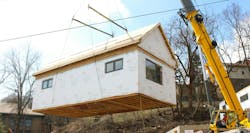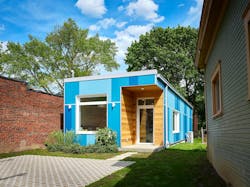The Modular Mark: Prefab Pros and Cons
Modular construction has been around for a while, and it’s only gaining attraction as better offsite construction standards are constantly being implemented. But what are the pros and cons of building homes this way, and are perceptions of the practice causing more harm than good?
This is exactly what modular builders discussed at the Housing Innovation Alliance’s 3rd Tuesday event in February. We asked some of these speakers about their thoughts, and what they believe are the reasons that a modular stigma sticks around.
HISTORIC PUBLIC PERCEPTION OF PREFAB
When it comes to homebuyers, they want to make sure that their dwellings are safe and sound. Some buyers believe that a house built from modular pieces just won’t hold up.
“It’s a perception challenge,” says Brian Gaudio, co-founder and CEO, Module. “The stigma in part of the population is that modular is cheaper, of a lower quality, and won't hold up. That’s purely based on the types of homes that have historically been built in factories.”
Offsite construction, however, involves building these individual modules in a contained, climate-controlled environment. A factory setting allows for more precise building techniques, and builders must make sure each unit is strong enough to be transported.
According to Riverview Homes, a Pennsylvania-based modular and mobile homes developer, site-built homes may encounter certain problems during the construction process—such as exposure to damaging weather conditions—that could alternatively be prevented through offsite construction.
HIDDEN BEHIND METAL WALLS
Another hesitancy that the public has toward modular construction is that it can be a bit of a “black box,” as Gaudio puts it.
“The process is more opaque, because a client can’t see what’s going on inside a factory, compared to a site-built project, where they can drive by and see what’s being built,” he says.
Gaudio argues that although that may be the case, modular building companies try to be as communicative as possible with their buyers throughout the whole process. He even says that “setting day” for a house—when they transport the units and put them together on the lot—can be just as exciting, if not more so, than closing day.
"The stigma in part of the population is that modular is cheaper, of a lower quality, and won't hold up. That’s purely based on the types of homes that have historically been built in factories." — Brian Gaudio, Co-founder and CEO, Module
The modular developer believes that over the next several years, the industry’s failures and successes will bring about a different perception of prefabrication and new means of production.
“More developers working in cities are using prefabrication as a delivery method, which is causing factories to change how they deliver products and the markets in which they operate,” he says.
SO… ARE THERE DOWNSIDES TO MODULAR?
There are a few reasons modular developers have had issues in the past. Gaudio says that the construction draw for building offsite is different, so some banks may be hesitant to lend to a modular project.
Shipping delays may arise, such as the sending materials to the factory, or even getting the units delivered to the lot. Gaudio says that in his experience, the difficulties with modular construction are only the ones that are out of his purview.
Riverview Homes looked into the historic resale value of modular homes as well. According to them, site-built homes traditionally retained their value better than modular homes, but that is no longer the case since modern modulars are well built, with high standards.
Modular home value adjusts with the market, and will appreciate over time. These homes can be improved or expanded on-site as well, to accommodate owners preferences and increase value.
ADVICE FOR BUILDERS
“Ultimately, being able to deliver a project using offsite construction is a tool in your arsenal and it can distinguish you from other builders or architects competing for a project,” says Gaudio.
Check out this testimonial video from Module on prefabricated homes:
It’s a method of construction that takes a bit of getting used to. Builders looking to diversify their production may want to consider taking a piece or two out of the modular handbook. Curtis Wong, founder and CEO of Cloud Apartments, wants developers to have an open mind.
"There’s a misconception that modular is riskier by definition," says Wong. "It’s really just because it’s new. Looking at it logically, you can test the individual units and modules for everything—building blocks are less risky."


